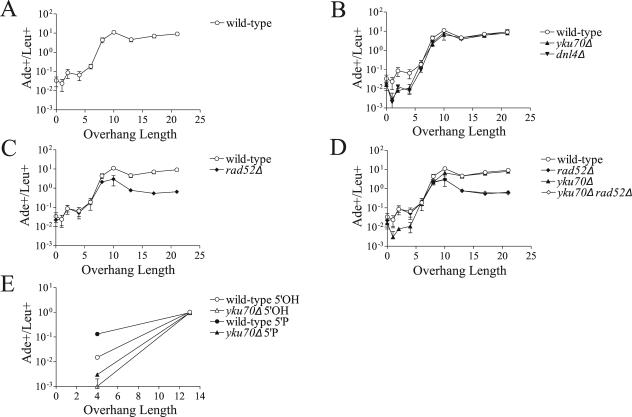FIG. 2.
Rejoining of DSBs with 3′ overhangs. (A) DSBs with 3′ overhangs are repaired more efficiently as the single-stranded overhang length increases. To control for transformation efficiency, repair is expressed as the ratio of Ade+ colonies arising from accurate repair of the linearized plasmid over Leu+ colonies resulting from uptake of a cotransformed supercoiled plasmid. This ratio can exceed 1 in part because 10-fold-more linear plasmid than circular plasmid is transformed. Each point represents the mean ± standard deviation (error bar) from four independent transformations. (B) DSB repair is independent of Yku70 and Dnl4 when overhangs are 6 nucleotides and longer. (C) Repair of DSBs with overhangs 8 nucleotides and longer is partially compromised in a rad52Δ strain. (D) In the absence of Rad52, DSBs with overhangs of >8 nucleotides are not repaired by Yku70-dependent NHEJ. Due to the decreased transformation efficiency of the yku70Δ rad52Δ strain, we were able to reliably assay only DSBs with overhangs of 6 nucleotides or longer at the plasmid concentration used. (E) Adding 5′ phosphates to DSBs enhances the repair of DSBs with 4- but not 13-base overhangs. Different carrier DNA and plasmid preparations were used in the experiment shown panel E than those used in the experiments shown in panels A to D, resulting in a different range in the linear to supercoiled plasmid transformation ratio. Variability in this ratio is common when changing reagents in yeast transformation experiments, as carrier DNA has nonequivalent effects on the uptake of linear and supercoiled DNA. This does not affect the interpretation of the data within an experiment, and similar trends are observed in panel E versus panels A to D.

